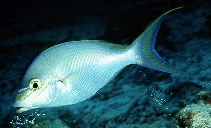| Family: |
Nemipteridae (Threadfin breams, Whiptail breams) |
| Max. size: |
38 cm TL (male/unsexed) |
| Environment: |
reef-associated; marine; depth range 2 - 50 m |
| Distribution: |
Indo-West Pacific: eastern Indian Ocean (Andaman Sea and northwest Australia) to Papua New Guinea, north to the Ryukyu Islands, south to northeastern Australia. This species has been previously reported as Scolopsis dubiosus (a junior synonym of Scolopsis taeniopterus), or misidentified as Scolopsis temporalis. |
| Diagnosis: |
Dorsal spines (total): 10-10; Dorsal soft rays (total): 9-9; Anal spines: 3-3; Anal soft rays: 7-7. Head scales reaching to between anterior margin of eyes and posterior nostrils. Lower limb of preopercle scaly. Antrorse (forward-directed) suborbital spine absent. Pelvic fins long, reaching almost to level of origin of anal fin. Upper lobe of caudal fin a little longer than lower lobe. In larger specimens, lobes produced to form short filamentous extensions in larger specimens. 3 blue stripes on snout; uppermost joining eyes above nostrils. A blue stripe on preopercle behind eye. A blue chevron-shaped stripe running upwards onto opercle from below eye and bending downward towards pectoral-fin base. |
| Biology: |
Occurs on sand bottoms close to reefs. Often silty habitats (Ref. 48635). Occurs solitary or in small groups. Feeds on small fishes, crustaceans, mollusks and polychaete worms (Ref. 90102). It is parasitised by the monogenean Anoplodiscus hutsonae on the pectoral fins and body surface (Ref. 124057). |
| IUCN Red List Status: |
Least Concern (LC); Date assessed: 03 March 2015 Ref. (130435)
|
| Threat to humans: |
harmless |
Source and more info: www.fishbase.org. For personal, classroom, and other internal use only. Not for publication.

